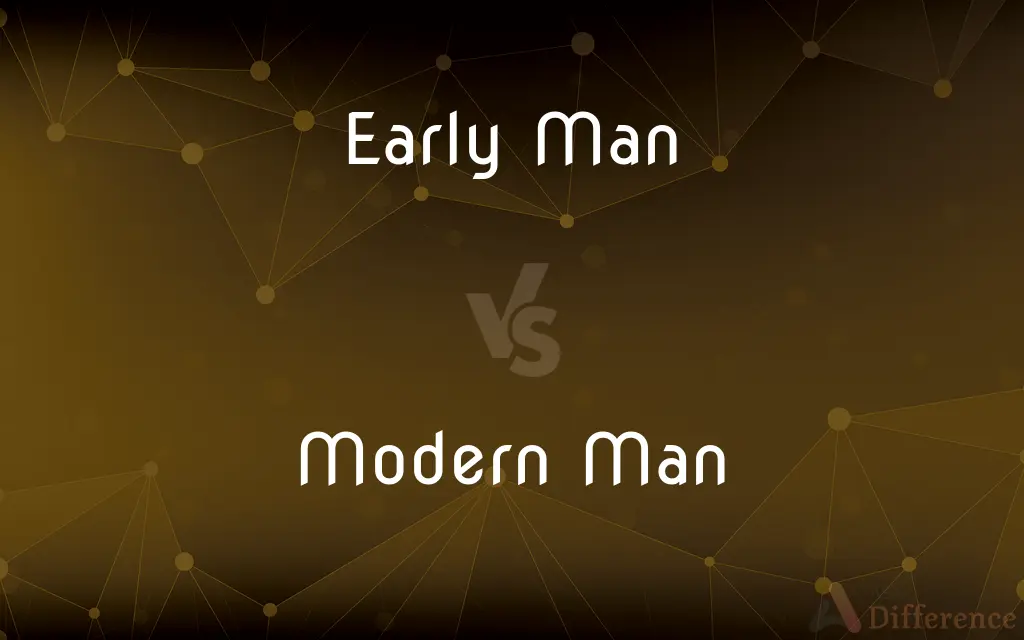Early Man vs. Modern Man — What's the Difference?
By Tayyaba Rehman — Published on November 13, 2023
Early Man refers to prehistoric hominids who lived millions of years ago. Modern Man denotes present-day Homo sapiens with advanced cognitive abilities and societal structures.

Difference Between Early Man and Modern Man
Table of Contents
ADVERTISEMENT
Key Differences
Early Man and Modern Man represent distinct evolutionary stages in human history. Early Man encompasses various species of hominids that appeared and lived primarily during the Pleistocene epoch. These ancestors of Modern Man walked on two feet, used primitive tools, and began the journey towards complex cognition.
Modern Man, scientifically known as Homo sapiens, showcases sophisticated language, abstract thinking, problem-solving abilities, and a profound cultural heritage. Unlike Early Man, Modern Man has crafted civilizations, developed intricate technologies, and has the capability to manipulate the environment on a massive scale.
While Early Man's primary challenges revolved around survival, facing threats from predators, and adapting to harsh environments, Modern Man grapples with socio-political issues, environmental concerns, and the complexities of a globally connected world.
In terms of physical characteristics, Early Man had a more robust physique with a larger brow ridge and a smaller brain capacity compared to Modern Man. The modern Homo sapiens possesses a larger brain, more refined facial features, and a more erect posture.
To summarize, while both Early Man and Modern Man are milestones in human evolutionary history, the former represents the initial stages of human development, while the latter epitomizes the pinnacle of evolutionary and cultural advancements.
ADVERTISEMENT
Comparison Chart
Time Period
Prehistoric times, primarily Pleistocene epoch
Present day
Physical Characteristics
Robust physique, larger brow ridge
More refined features, larger brain capacity
Cognitive Abilities
Beginning of complex cognition
Advanced language, abstract thinking
Tools and Technology
Primitive stone tools
Complex technology, computers
Primary Concerns
Survival, basic shelter, hunting
Socio-political issues, technology, environment
Compare with Definitions
Early Man
Prehistoric hominids predating Homo sapiens.
The discovery of Lucy gave insight into the lifestyle of Early Man.
Modern Man
Representative of the pinnacle of human evolution and culture.
The achievements of Modern Man span from space exploration to digital revolutions.
Early Man
Humans from the Pleistocene epoch with primitive cognitive abilities.
The cave paintings provide a glimpse into the mind of Early Man.
Modern Man
Current evolutionary stage of humans with societal structures.
Modern Man has established governmental systems and laws for order.
Early Man
Ancestors of modern humans with rudimentary tool usage.
Early Man primarily used stone tools for hunting and gathering.
Modern Man
Humans with the capacity for abstract thinking and complex language.
The literature and arts of Modern Man reflect profound thought and creativity.
Early Man
Hominids with basic survival instincts and challenges.
Early Man developed fire to protect against the cold and predators.
Modern Man
Homo sapiens with the capability to influence the global environment.
The actions of Modern Man have led to concerns about climate change.
Early Man
Initial stages of human evolution with distinct physical features.
The skeletal remains of Early Man show a robust physique.
Modern Man
Present-day Homo sapiens with advanced cognitive abilities.
Modern Man has crafted intricate societies and technologies.
Common Curiosities
Did Early Man use tools?
Yes, Early Man used primitive tools primarily made of stone.
Who are considered Early Man?
Early Man refers to prehistoric hominids that lived before the emergence of Homo sapiens.
What has enabled Modern Man's advanced societal structures?
Cognitive advancements, language development, and collaborative abilities have played roles.
What's a key difference in the physical appearance of Early and Modern Man?
Early Man had a more robust build and larger brow ridge, while Modern Man has more refined features.
Were there multiple species of Early Man?
Yes, including Homo erectus, Neanderthals, and Australopithecus, among others.
What distinguishes Modern Man from its ancestors?
Modern Man has advanced cognitive abilities, societal structures, and technology.
Did Early Man have language?
They likely had rudimentary forms of communication, but not complex languages like Modern Man.
What types of shelters did Early Man use?
Early Man used natural shelters like caves or rudimentary huts.
In what ways has Modern Man's diet evolved from Early Man's?
Modern Man has a more varied diet, including processed foods, while Early Man relied on hunting and gathering.
Did Early Man and Modern Man ever coexist?
Homo sapiens (Modern Man) did overlap and interact with other hominid species like Neanderthals.
How has Modern Man impacted the environment?
Modern Man's activities have led to climate change, deforestation, and pollution.
Where can I find fossils of Early Man?
Fossils have been discovered in various parts of the world, notably in Africa's Rift Valley.
How does Modern Man's lifespan compare to Early Man's?
Modern Man typically has a longer lifespan due to advancements in medicine and living conditions.
Did Early Man have beliefs or religions?
While hard to confirm, some archaeological evidence suggests spiritual or ritualistic practices.
How has Modern Man's mode of communication evolved?
From verbal stories and hand-written texts, Modern Man now uses digital media and the internet.
Share Your Discovery

Previous Comparison
Center of Gravity vs. Center of Mass
Next Comparison
Federal Law vs. State LawAuthor Spotlight
Written by
Tayyaba RehmanTayyaba Rehman is a distinguished writer, currently serving as a primary contributor to askdifference.com. As a researcher in semantics and etymology, Tayyaba's passion for the complexity of languages and their distinctions has found a perfect home on the platform. Tayyaba delves into the intricacies of language, distinguishing between commonly confused words and phrases, thereby providing clarity for readers worldwide.












































